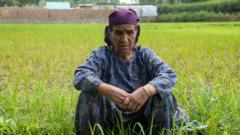Heavy rains recently provided fleeting relief; however, experts warn that this may not be enough to mitigate the ongoing crisis. For many farmers, like Begum, the unpredictable weather has resulted in a profound decline in the quality and quantity of their harvests over recent years. As farmers around the valley have struggled through successive dry seasons, the impact on their lives and livelihoods is becoming increasingly grim.
In Bandipore district, Ali Mohammad struggles to keep his apple orchard alive, stating a severe lack of necessary rain has left many trees wilted. He switched to apple farming due to the unreliable water sources for rice cultivation, but now even his orchards cannot endure the scorching conditions. Local residents, unaccustomed to such heat, have also been severely affected, with some suffering health issues due to the extreme temperatures.
Environmental specialists attribute this shift to climate change, predicting that prolonged dry spells will become increasingly frequent. The disruption has raised concerns over long-term water security, agriculture, and biodiversity, as waters from melting glaciers become less available.
Although Kashmir's contribution to global carbon emissions is minimal, it is disproportionately affected by climate issues it did not create. Urbanization and deforestation in the region further exacerbate these environmental changes, causing local atmospheric imbalance. The reliance on air conditioning is a new trend, leading to higher energy consumption and more emissions.
Despite the evident crisis, agricultural and environmental issues remain sidelined in Kashmir's political discourse. Officials claim to take the current reality seriously, citing the need for broader action to mitigate the effects of climate change. Yet, farmers like Begum urgently call for immediate interventions to salvage their livelihoods, fearing an uncertain future if action does not come quickly.
As Kashmir continues to face these formidable challenges, the interconnection of health, agriculture, and climate remains at the forefront of ongoing dialogues within the region.
In Bandipore district, Ali Mohammad struggles to keep his apple orchard alive, stating a severe lack of necessary rain has left many trees wilted. He switched to apple farming due to the unreliable water sources for rice cultivation, but now even his orchards cannot endure the scorching conditions. Local residents, unaccustomed to such heat, have also been severely affected, with some suffering health issues due to the extreme temperatures.
Environmental specialists attribute this shift to climate change, predicting that prolonged dry spells will become increasingly frequent. The disruption has raised concerns over long-term water security, agriculture, and biodiversity, as waters from melting glaciers become less available.
Although Kashmir's contribution to global carbon emissions is minimal, it is disproportionately affected by climate issues it did not create. Urbanization and deforestation in the region further exacerbate these environmental changes, causing local atmospheric imbalance. The reliance on air conditioning is a new trend, leading to higher energy consumption and more emissions.
Despite the evident crisis, agricultural and environmental issues remain sidelined in Kashmir's political discourse. Officials claim to take the current reality seriously, citing the need for broader action to mitigate the effects of climate change. Yet, farmers like Begum urgently call for immediate interventions to salvage their livelihoods, fearing an uncertain future if action does not come quickly.
As Kashmir continues to face these formidable challenges, the interconnection of health, agriculture, and climate remains at the forefront of ongoing dialogues within the region.






















